This set of Structural Analysis Multiple Choice Questions & Answers (MCQs) focuses on “Stiffness-Factor Modifications”.
1. When a structural member of the uniform section is subjected to a moment at one end only, then the moment required so as to rotate that end to produce a unit slope, is called _____
a) Resistance of member
b) Stiffness of member
c) Capacity of member
d) Potential of member
View Answer
Explanation: When a structural member of the uniform section is subjected to a moment at one end only, then the moment required so as to rotate that end to produce a unit slope, is called stiffness of the member. Stiffness is basically a measure of the ability of the member to resist rotational deformation.
2. Stiffness of the end A if the far end B is fixed is ____

a) \(\frac{EI}{L} \)
b) \(\frac{2EI}{L} \)
c) \(\frac{3EI}{L} \)
d) \(\frac{4EI}{L} \)
View Answer
Explanation: If a unit rotation is to be caused at an end A for the far end being fixed supported. Moment of \(\frac{4EI}{L} \) is to be applied at end and hence stiffness for the member is said to be \(\frac{4EI}{L} \).
3. Required Moment that is to be applied at end A to produce unit rotation if the far end is hinged is _____

a) \(\frac{EI}{L} \)
b) \(\frac{2EI}{L} \)
c) \(\frac{3EI}{L} \)
d) \(\frac{4EI}{L} \)
View Answer
Explanation: If a unit rotation is to be caused at an end A for the far end being hinged support. Moment of \(\frac{3EI}{L} \) is to be applied at end and hence stiffness for the member is said to be \(\frac{3EI}{L} \).
4. Required Moment that is to be applied at both ends to produce unit rotation on both the simply supported support is _____
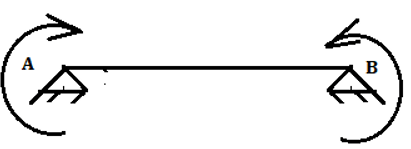
a) \(\frac{EI}{L} \)
b) \(\frac{2EI}{L} \)
c) \(\frac{3EI}{L} \)
d) \(\frac{4EI}{L} \)
View Answer
Explanation: If a unit rotation is to be caused at an end A for the far end being hinged support. Moment of \(\frac{2EI}{L} \) is to be applied at end A and B and hence stiffness for the member is said to be 2EI/L.

5. Stiffness of the end A if the far end B is vertical guided roller is ____

a) \(\frac{EI}{L} \)
b) \(\frac{2EI}{L} \)
c) \(\frac{3EI}{L} \)
d) \(\frac{4EI}{L} \)
View Answer
Explanation: If a unit rotation is to be caused at an end A for the far end being vertical guided roller support. Moment of \(\frac{EI}{L} \) is to be applied at end A and hence stiffness for the member is said to be \(\frac{EI}{L} \).
6. Stiffness of the end A if the far end B is free is ____
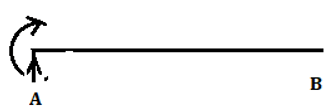
a) \(\frac{EI}{L} \)
b) \(\frac{2EI}{L} \)
c) \(\frac{3EI}{L} \)
d) 0
View Answer
Explanation: As free end cannot resist any moment nor can support any vertical or horizontal reactions. End support B cannot take any portion of the moment applied at end A. Thus, stiffness for the member would be zero.
7. Required Moment that is to be applied at end A to produce unit rotation if the far end is vertical roller support as shown in the figure is _____

a) \(\frac{EI}{L} \)
b) \(\frac{2EI}{L} \)
c) \(\frac{3EI}{L} \)
d) \(\frac{4EI}{L} \)
View Answer
Explanation: If a unit rotation is to be caused at an end A for the far end being roller support. Moment of \(\frac{3EI}{L} \) is to be applied at end and hence stiffness for the member is said to be \(\frac{3EI}{L} \).
8. Required Moment that is to be applied at end A to produce unit rotation if the far end is horizontal roller support as shown in the figure is _____

a) \(\frac{EI}{L} \)
b) \(\frac{2EI}{L} \)
c) \(\frac{3EI}{L} \)
d) 0
View Answer
Explanation: Since the horizontal roller support does not provide any restraint to the vertical loading if the moment is applied at that end. The end will simply slide down and hence would not resisting any portion of the applied moment.
9. Rotational stiffness at joint O for the shown the figure is _____
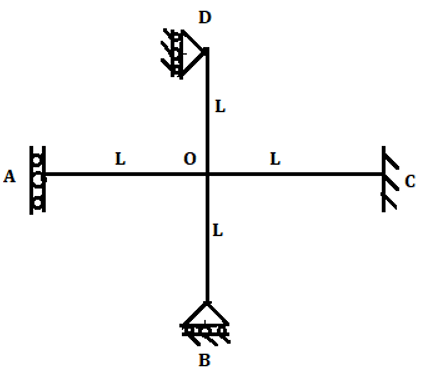
a) \(\frac{11EI}{L} \)
b) \(\frac{13EI}{L} \)
c) \(\frac{7EI}{L} \)
d) \(\frac{8EI}{L} \)
View Answer
Explanation: Joint O is connected to the four-member OA, OB, OC, and OD where far end is supported by vertical guided roller, vertical roller support, fixed support, and horizontal roller support respectively.
Stiffness for OA is \(\frac{EI}{L} \)
Stiffness for OB is 0
Stiffness for OC is \(\frac{4EI}{L} \)
Stiffness for OD is \(\frac{3EI}{L} \)
Therefore stiffness for joint O is the sum of the stiffness for all the members connected to it.
Stiffness for the joint O is \(\frac{EI}{L}+0+\frac{4EI}{L}+\frac{3EI}{L}=\frac{8EI}{L} \)
10. Rotational stiffness at joint O for the shown the figure is _____
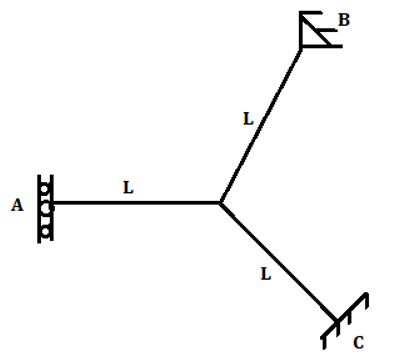
a) \(\frac{10EI}{L} \)
b) \(\frac{6EI}{L} \)
c) \(\frac{9EI}{L} \)
d) \(\frac{8EI}{L} \)
View Answer
Explanation: Joint O is connected to the four-member OA, OB, and OD where far end is supported by vertical guided roller, fixed support, and hinged support respectively.
Stiffness for OA is \(\frac{EI}{L} \)
Stiffness for OB is \(\frac{3EI}{L} \)
Stiffness for OC is \(\frac{4EI}{L} \)
Therefore stiffness for joint O is the sum of the stiffness for all the members connected to it.
Stiffness for the joint O is \(\frac{EI}{L}+0+\frac{4EI}{L}+\frac{3EI}{L}=\frac{8EI}{L} \)
11. Rotational stiffness at joint O for the shown the figure is _____
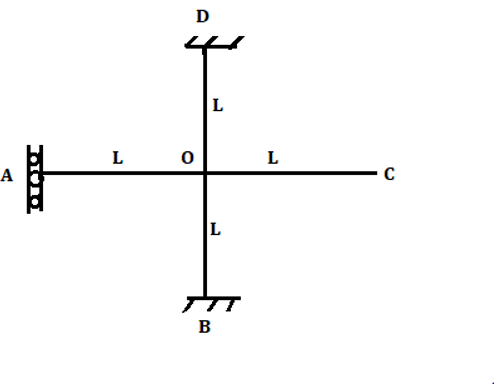
a) \(\frac{9EI}{L} \)
b) \(\frac{10EI}{L} \)
c) \(\frac{11EI}{L} \)
d) \(\frac{14EI}{L} \)
View Answer
Explanation: Joint O is connected to the four-member OA, OB, OC, and OD where far end is supported by vertical guided roller, fixed support, the free end, and fixed support respectively.
Stiffness for OA is \(\frac{EI}{L} \)
Stiffness for OB is \(\frac{4EI}{L} \)
Stiffness for OC is 0
Stiffness for OD is \(\frac{4EI}{L} \)
Therefore stiffness for joint O is the sum of the stiffness for all the members connected to it.
Stiffness for the joint O is \(\frac{EI}{L}+0+\frac{4EI}{L}+\frac{4EI}{L}=\frac{9EI}{L} \)
12. Distribution factor is the ratio in which force sharing capacity of various members meeting at a rigid joint.
a) True
b) False
View Answer
Explanation: Distribution factor is the ratio in which moment sharing capacity of various members meeting at a rigid joint.
Sanfoundry Global Education & Learning Series – Structural Analysis.
To practice all areas of Structural Analysis, here is complete set of 1000+ Multiple Choice Questions and Answers.
If you find a mistake in question / option / answer, kindly take a screenshot and email to [email protected]
- Apply for Civil Engineering Internship
- Check Civil Engineering Books
- Check Structural Analysis Books
- Practice Civil Engineering MCQs
